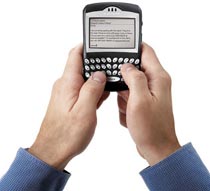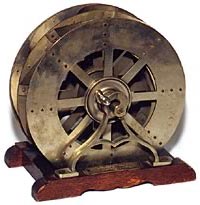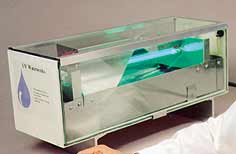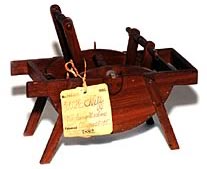| (insert your NIE or newspaper logo here) |
Weekly Online LessonOnline Lesson ArchiveGrade Level: 6-8
|
Patent Power
 The
BlackBerry is a powerful tool for on-the-go professionals,
who want e-mail, calendars and
phones at their fingertips 24/7.
The
BlackBerry is a powerful tool for on-the-go professionals,
who want e-mail, calendars and
phones at their fingertips 24/7.
Since its introduction in 1999, BlackBerry use has grown from 25,000 subscribers to more than 3.5 million.
But the BlackBerry's maker, Research In Motion (RIM), came close to having its boom turn to bust. Another company, called NTP Inc., filed suit against RIM in 2001, claiming that RIM infringed on their patent rights.
A patent is a protection granted by the government which gives the creator of an invention the sole right to make, use, and sell that invention for a set period of time. During the original ownership term, other inventors can use the patents owned by other inventors, but only with permission. In the case of RIM and NTP, NTP holds several patents relating to wireless e-mail technology which RIM has used in BlackBerry devices—without NTP's permission.
Recently, RIM was found guilty of the charges. The next judgment by the court would have likely placed an injunction on RIM. At minimum, an injunction would have meant pulling BlackBerry devices from stores and dealing with shaky subscriber confidence.
But negotiations were successful, RIM announced on Friday, March 3, 2006. They had agreed to pay NTP $612.5 million. The agreement pays a fair share of the profits from using the patents, plus full license to continue using them.
The first U.S. patents were granted in 1790, and the number of annual applications has grown from a few dozen to many thousands. Patents not only help protect the rights of the original inventors, but they also provide an evolving—and accessible—collection of ideas and useful innovations that give a big boost to modern technologies.
 During
this week's lesson, you'll learn more about the patent
process and how patents have shaped modern society.
You'll also become a Patent Detective, so you can investigate
some of the patents built into things you use every day.
During
this week's lesson, you'll learn more about the patent
process and how patents have shaped modern society.
You'll also become a Patent Detective, so you can investigate
some of the patents built into things you use every day.
The Evolution of Innovation
First, let's think about how invention builds upon invention, continuously building modern society.
To do that, play a couple of Games hosted at the Lemelson-MIT site, Inventing Modern America: From the Microwave to the Mouse.
Start by playing the Invention Connection, making sure to read about each invention along the path.
Then, play the Which Came First? game. Were you surprised by any of the answers?
Let's take a closer look at a few inventors who can claims several original patents. First, meet Doug Engelbart. Read his Biography, review his Patents, and watch the related Videos.
Meet a few other inventors here, including Thomas Fogarty, Ashok Gadgil, Stephanie Kwolek, and Paul MacCready.
What inspired or motivated each person to create and patent their inventions? What is the purpose of each invention? What are the practical applications?
The Patent Process
 Let's learn about the patent system itself at Invent
Now, hosted at the National Inventors Hall
of Fame.
Let's learn about the patent system itself at Invent
Now, hosted at the National Inventors Hall
of Fame.
Once in the door, head to the Workshop on How to Patent. Review the introduction, and as you browse through the following pages, think about how each photo of the featured invention has evolved into modern forms and products.
Begin by getting into the background and definitions of Patents—Pathways to Progress. Why did lawmakers decide to protect inventors' rights? What did Abraham Lincoln say about the patent system?
Next find out, What is patent protection? What happens after the original patent expires? What are the Classifications of different types of patents? Write down each definition, including term length, for later reference. In what ways is a patent similar to other types of personal property?
Lastly at this site, you'll discover the Importance of Patents and how patented inventions touch our lives every day.
The U.S. Trademark & Patent Office
 Your
next stop is the U.S. Trademark & Patent Office.
Your
next stop is the U.S. Trademark & Patent Office.
Here, you'll learn how to be a Patent Detective. Start with reviewing the Junior Detective method, using the patent number.
To practice, find an item or two with patent numbers stamped on them and do a Junior Detective Search for each one. Write down the key words of each patent description. What exactly does the patent cover regarding the product's purpose or composition?
If you have time now or on another day, work your way up to a Master Detective to search patents by an inventor's name. If you're really ambitious, continue to the Super Detective level and beyond.
Newspaper Activities
This activity starts with a scavenger hunt and will rely upon your new detective skills. Leaf through Targetnewspaper and cut out three to five pictures of products you would have a chance to pick up and examine closely. Look over each product and write down all of the patent numbers you can find. Use your Patent Detective skills to track down the patent descriptions. Under what classification does the patent fall? When did, or when will, the patent expire? Share your list of products and patents with the class. As a group, brainstorm about what inventions may be related to the item or patent(s). Also, list ways in which the product could be improved upon. Group together any products which share one or more patents.
© Copyright 2006
Learners Online, Inc.
